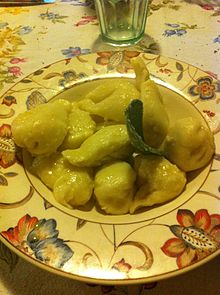Culurgiones
This articleneeds additional citations forverification.(May 2024) |
 | |
| Place of origin | Italy |
|---|---|
| Region or state | Sardinia |

Culurgiones(name inSardinian language;also calledculurgionis,culurjones,culijonis,culurjonis,culunjonis,culinjonis,culurzones,orangiulotus,'agnolotti';Italian:culurgioni,sg.:culurgione) are a type of Sardinianravioli-likestuffed pasta.It exists in a version made of potatoes,pecorino cheeseand mint, a typical culinary specialty of the sub-region ofOgliastra,and in several other recipes adopted in the rest of the island, such as inGallura,where the product is aromatized with lemon or orangepeel.[1]
Since 2015 theculurgionis d'Ogliastrahas been recognised as aprotected geographical indication(PGI) product.
Variants
[edit]The dish, depending on the country of origin, is present in several variants:
- inOgliastraand in the inland areas (includingSadali,on the border with Ogliastra) they are prepared with freshdurum wheatsemolinadough and a filling of Sardinianpecorino cheese(fresh for one or two days, as inTalana,or aged in other towns), or with a filling ofpotatoes,garlicandmintas inGairo,UlassaiandBari Sardo.In the latter town, instead of pecorino,fisciduis used, a particular sour cheese put in brine, and the culurgione is closed with the fingers so as to form a small spiga. InJerzu,the mint is replaced bynepidedda(nepitella). The culurgione is then cooked in boiling water and seasoned with olive oil, lately with tomato sauce and grated pecorino cheese.
- spighittaclosing method on both sides is a characteristic of the villages of Jerzu, Talana,Urzulei,Bari Sardo andIlbono.
- in all the mountain areas of Ogliastra and in Bari Sardo the stuffing is strictly accompanied by garlic, while in coastal Ogliastra bysofrittaonion.
- theculurzonesofBarbagia di Ollolai,also imported from Ogliastra, are stuffed with fresh pecorino cheese and are served with a tomato sauce and diced pork, or alternatively with tomato sauce and fresh sausage, all topped with grated aged pecorino cheese.
- insouthern Sardinia,and generally in theCampidanoarea, there are other recipes forculurgiones:the ravioli is prepared with fresh durum wheatsemolinapastawith a filling of fresh sheep or goatricotta cheese,eggandsaffron(and the addition in some cases of Sardinian pecorino cheese,nutmeg,chardorspinach). After cooking, the culurgioni is seasoned with freshtomato sauce,chilli pepperandbasiland a sprinkling of pecorino or other grated cheese. InTeulada,on the other hand, a simpler recipe is preferred, with a filling of fresh goat cheese (sheep cheese is less frequent) in the quadrangularculurgiones(culixionisin the local dialect). The seasoning is usually tomato sauce and a sprinkling of aged goat cheese.
Additional information
[edit]In the village of Ulassai, until the 1960s, the tradition was to consumeculurgionesexclusively onAll Souls' Day(sa di' de sos mortus).[2]
Throughout Ogliastra and in the villages of Sadali andEsterziliof theBarbagia of Seulo,culurgiones(culurxonis,culurgionisorculingionis) are not considered just food, but may also be presented as a gift. They were prepared on special occasions such as thanksgiving at the end of the wheat harvest, to remember and honor the dead, on All Souls' Day in November, with sheep fat (culurgioni de ollu de seu), to celebrateCarnivalin February, withlard(culurgioni de ollu de procu). thespighitta,the typical closure ofculurgiones,represents the symbol of wheat to propitiate the new agricultural year at the end of August. According to the tradition they were also considered amulets thatprotected the family from mourning.[clarify]
See also
[edit]References
[edit]- ^Cristina Ortolani (2003).L'Italia della pasta.Touring Editore. p. 131.ISBN978-88-365-2933-9.
- ^"La notte delle anime".ponzaracconta.it.24 October 2013.
Bibliography
[edit]- Cristina Ortolani (2003).L'Italia della pasta.Touring Editore. p. 131.ISBN9788836529339.
- Mille ricette della cucina italiana. Il più grande e ricco libro illustrato dedicato alla tavola del nostro paese.Rizzoli. 2010.ISBN9788817041669.
External links
[edit]- (PDF)Culurgionessu Sardegnaagricoltura.it
- "Ricetta Culurgionis d'Ogliastra".GialloZafferano.it.
- Spighitta Culurgionis D'Ogliastrasu YouTube
